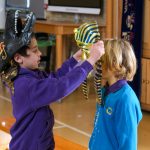In the Summer term, Zayit and Seorah classes worked on their first extended project across two half terms. This was focused on our topic of ‘Farms’ and linked with learning related to our big question: ‘How can I tell a story?’ The Farm themed project enabled us to learn all about farm animals, caring for animals and animal life cycles. One aspect of this was looking after eggs and watching them hatch and grow as chicks. We also explored Scratch Junior to develop programming skills and create farm scenes. The second aspect of our project developed the children’s literacy, drama and expressive arts skills as they participated in staging a performance of ‘The Enormous Turnip’. This was an incredible show for us to share with family and friends, and involved the children acting, singing, developing their costumes and props and improving their confidence and communication with a wider range of people. The children took portraits of each other to use for the show programme and enjoyed reading and writing activities linked to a variety of farm-themed traditional tales as we built towards our performance. We had so much fun in the summer term learning all about farms and stories!
Teacher’s Reflections
“The Farms project was amazing and the children gained so much confidence, knowledge and enjoyment from it. They have matured so much throughout the year and The Enormous Turnip stage show was a highlight of the year for the children, staff and families. As part of our focus on traditional tales, the children created story maps and retold a number of different stories over the term, allowing them to build familiarity and confidence with retelling in small groups, before they started work on learning lines and songs to perform for their Gesher friends across the school and families. Everyone worked together to create costume hats and props for the show and they were all so supportive of each others’ acting and singing skills. The most challenging part of this project was developing stage directions and supporting the children to learn stage presence and be focused on performing to the audience. Luckily we had a number of weeks to focus on the show staging and we were able to enable the children to do their best performance by moving from script read throughs (using visuals), to practising staging in the classroom, then in the hall space and finally on our stage. We also had a number of dress rehearsals for other classes at Gesher, before we performed our final show for the children’s families. The Farms project was a huge success and showed that Gesher has future stars in the acting, singing and entertainment industry!”
– Leigh Kennedy
Students’ Reflections
“I really enjoyed being in the show and going to the farm to see some pigs!” – Eli
“I learned about farm animals and how to look after chicks.” – Zephania
























